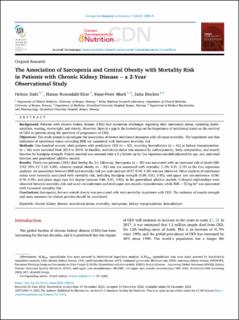| dc.description.abstract | Background
Patients with chronic kidney disease (CKD) face numerous challenges regarding their nutritional status, including undernutrition, wasting, overweight, and obesity. However, there is a gap in the knowledge on the importance of nutritional status on the survival of CKD in patients along the spectrum of progression of CKD.
Objectives
This study aimed to investigate the association of several nutritional measures with all-cause mortality. The hypothesis was that indicators of nutritional status exceeding BMI are associated with increased mortality risk.
Methods
One-hundred seventy adult patients with predialysis CKD (n = 82), receiving hemodialysis (n = 42) or kidney transplantation (n = 46) were recruited from 2014 to 2019. At baseline, nutritional status was assessed by anthropometry, body composition, and muscle function by handgrip strength. Patient survival was assessed after a 2-y follow-up by Cox regression models adjusted for age, sex, and renal function and generalized additive models.
Results
Thirty-one patients (18%) died during the 2-y follow-up. Sarcopenia (n = 30) was associated with an increased risk of death (HR: 2.92; 95% CI: 1.24, 6.89), whereas central obesity (n = 82) was not associated with mortality (1.05; 0.51, 2.15) in the Cox regression analyses. An association between BMI and mortality risk per unit increase (0.97; 0.90, 1.05) was not observed. Other markers of nutritional status were inversely associated with mortality risk, including handgrip strength (0.89; 0.83, 0.95), mid-upper arm circumference (0.86; 0.78, 0.95), and phase angle (per 0.1 degree increase 0.86; 0.81, 0.92). In the generalized additive models, U-shaped relationships were observed between mortality risk and waist circumference and mid-upper arm muscle circumference, while BMI < 22 kg/m2 was associated with increased mortality risk.
Conclusions
Sarcopenia, but not central obesity was associated with total mortality in patients with CKD. The inclusion of muscle strength and mass measures in clinical practice should be considered. | en_US |

